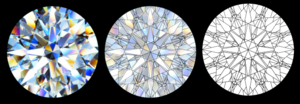Hello all,
I recently bought an engagement ring for my girlfriend and so my search is over.
However, being the geek that I am... I get more and more curious about diamonds.
I never really quite understood the implications of 'Lower halfs' and star lengths.
Crown and pavilion angles I get.. mirrors and prisms... but lower half and star lengths? How do they affect light performance?
For example... the diamond I chose for my girlfriend is slightly steep/deep... with 35.5/40.8. It is triple excellent GIA but as far as I understand it won't be an AGS 0.
I'm very happy with how it looks and so I'm keeping it. Fine by me. And in a week time...I'm pretty sure my girlfriend will too
Now I read somewhere in the depths of price scope that for that specific combination...35.5/40.8...the lower half percentage matters a lot...but noone seems to be able to explain how
my diamond has a 75% lower half and a 50% star length.. not cutlet..and medium girdle.
How would the same 35.5/40.8 diamond perform with a 80% lower half...and a 45% star length... for example?
Essentially, what do these two things do???
I recently bought an engagement ring for my girlfriend and so my search is over.
However, being the geek that I am... I get more and more curious about diamonds.
I never really quite understood the implications of 'Lower halfs' and star lengths.
Crown and pavilion angles I get.. mirrors and prisms... but lower half and star lengths? How do they affect light performance?
For example... the diamond I chose for my girlfriend is slightly steep/deep... with 35.5/40.8. It is triple excellent GIA but as far as I understand it won't be an AGS 0.
I'm very happy with how it looks and so I'm keeping it. Fine by me. And in a week time...I'm pretty sure my girlfriend will too
Now I read somewhere in the depths of price scope that for that specific combination...35.5/40.8...the lower half percentage matters a lot...but noone seems to be able to explain how
my diamond has a 75% lower half and a 50% star length.. not cutlet..and medium girdle.
How would the same 35.5/40.8 diamond perform with a 80% lower half...and a 45% star length... for example?
Essentially, what do these two things do???




300x240.png)